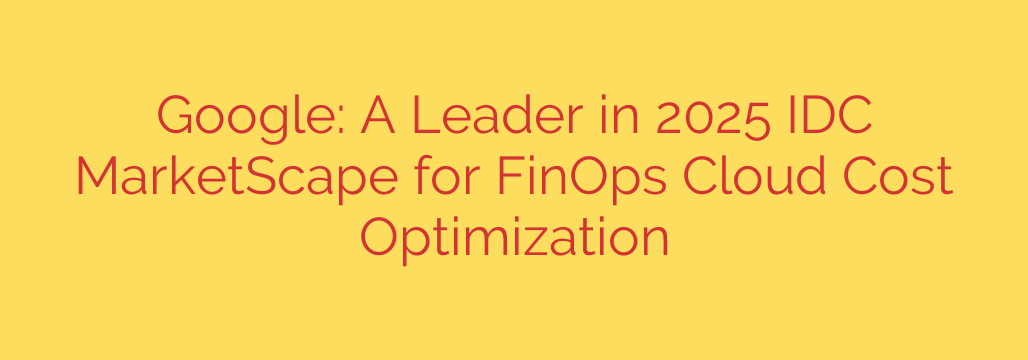
Unlocking Cloud Savings: How AI is Revolutionizing FinOps and Cost Optimization
As businesses increasingly migrate to the cloud, a new challenge has emerged: controlling spiraling costs. The very flexibility that makes the cloud so powerful—its scalability and on-demand resources—can lead to budget overruns and financial surprises. The solution isn’t to scale back innovation but to adopt a smarter, more strategic approach to cloud financial management, a practice known as FinOps.
Today, leading cloud platforms are embedding sophisticated, AI-driven tools directly into their ecosystems, transforming how organizations can manage, optimize, and forecast their spending. This shift moves companies from a reactive stance on cost management to a proactive, data-driven strategy that aligns financial goals with engineering and business objectives.
The FinOps Foundation: More Than Just Tools
At its core, FinOps is a cultural practice that fosters shared responsibility for cloud spending across an organization. It breaks down the silos between Finance, IT, and business units, creating a common language and set of goals. The aim is to empower teams with the visibility and data they need to make cost-aware decisions without stifling speed or innovation.
A successful FinOps strategy is built on three key pillars, often referred to as the “Inform, Optimize, and Operate” lifecycle. Modern cloud cost tools are now designed to support every stage of this journey.
Pillar 1: Gaining Full Visibility (Inform)
You can’t control what you can’t see. The first step in any cost optimization effort is achieving complete and real-time visibility into your cloud usage and spending. This goes beyond a simple monthly bill.
Effective cost management begins with granular dashboards that can slice and dice data by project, team, service, or custom labels. This allows you to answer critical questions:
- Which services are consuming the most budget?
- Which projects are driving cost increases?
- Is our spending aligned with our business priorities?
By providing a single source of truth, these tools ensure everyone from the CFO to the individual developer is working with the same information, creating a foundation for intelligent decision-making.
Pillar 2: Proactive Optimization with AI (Optimize)
This is where the real transformation is happening. Instead of relying on manual analysis, organizations can now leverage AI-powered recommendations to identify savings opportunities automatically. Leading cloud platforms offer sophisticated “recommenders” that constantly scan your environment for inefficiencies.
Key areas for AI-driven optimization include:
- Rightsizing Recommendations: Intelligently analyzing usage patterns to suggest downsizing over-provisioned virtual machines or databases, a primary source of wasted spend.
- Identifying Idle Resources: Flagging forgotten virtual machines, unattached storage volumes, and other zombie assets that accumulate costs without providing any value.
- Commitment-Based Savings: Analyzing your consistent usage to recommend purchasing savings plans or committed-use discounts, which can offer significant savings over on-demand pricing.
By automating these insights, organizations can free up engineers to focus on building products, not combing through billing data.
Pillar 3: Maintaining Continuous Governance (Operate)
FinOps is not a one-time project; it’s an ongoing discipline. The “Operate” phase is about embedding cost-awareness into your daily operations through continuous monitoring and governance.
Actionable tools in this area are crucial for maintaining financial control:
- Intelligent Budgeting and Alerts: Set granular budgets for projects or teams and configure automated alerts that notify stakeholders before they are projected to exceed their budget, not after.
- AI-Powered Anomaly Detection: One of the most powerful advancements is the use of machine learning to automatically detect unusual spikes in spending. This system learns your normal spending patterns and can instantly flag a deviation, helping you catch configuration errors or unexpected usage before they turn into a major financial incident.
- Accurate Forecasting: Leverage predictive analytics to forecast future cloud spending with greater accuracy, enabling better long-term financial planning and resource allocation.
Actionable Steps for Implementing a Strong FinOps Strategy
Ready to take control of your cloud costs? Here are four practical steps to get started:
- Foster a Cost-Aware Culture: Begin by educating teams on the financial impact of their technical decisions. Establish shared goals and create a cross-functional FinOps team with members from Finance, Engineering, and Operations.
- Leverage Native Cloud Tools: Before investing in third-party solutions, explore the rich set of cost management tools offered by your cloud provider. These tools are deeply integrated and are becoming increasingly sophisticated.
- Automate and Act on Recommendations: Don’t just view the AI-driven recommendations—act on them. Set a process for reviewing and implementing suggestions for rightsizing and eliminating waste. The more you automate, the more you save.
- Implement Budget Alerts and Anomaly Detection: Proactively set up budgets and enable anomaly detection. This is your safety net, ensuring that you can respond quickly to unexpected costs and maintain financial predictability.
Ultimately, mastering cloud costs is no longer an insurmountable challenge. By embracing the principles of FinOps and leveraging the powerful, AI-enhanced tools now available, businesses can finally align their cloud spending with their strategic goals, ensuring every dollar invested delivers maximum value.
Source: https://cloud.google.com/blog/topics/cost-management/google-leader-in-idc-marketscape-finops-cloud-costs/








